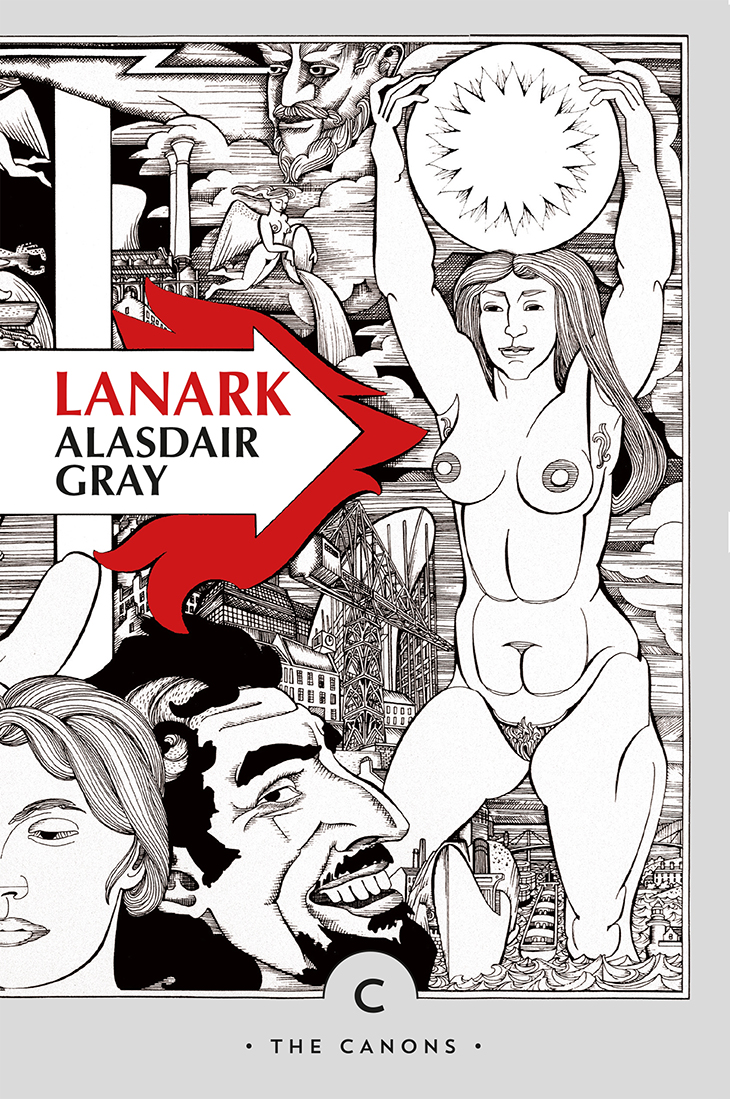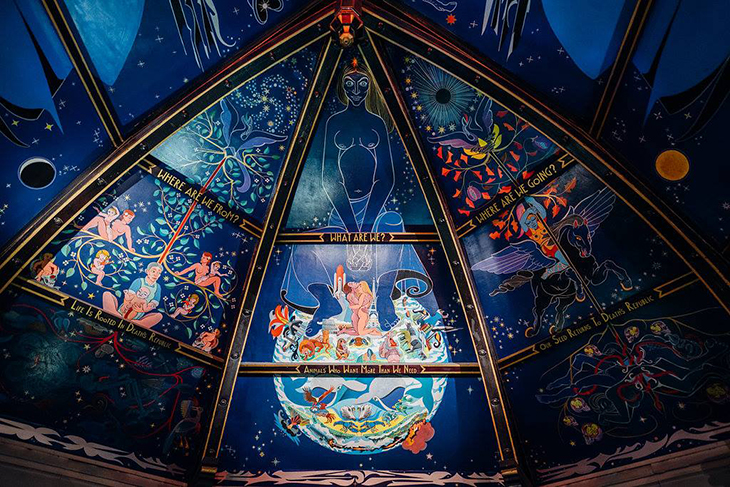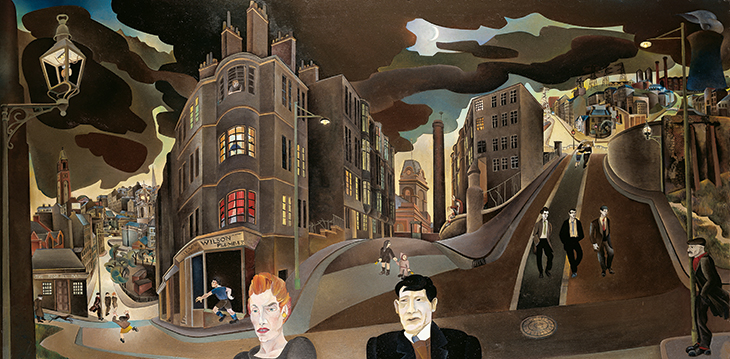Alasdair Gray, who died on 29 December 2019, will be remembered as a transformative figure in post-war Scottish art and letters – a painter-novelist whose idiosyncratic painting and unique combination of realism and fantasy shaped the imagination of late 20th- and early 21st-century Scotland.
‘Art,’ he wrote in his masterpiece Lanark (1981), ‘is the only work open to people who can’t get along with others and still want to be special.’ Gray himself was no hermit – his many luminous portraits of friends and family testify to a warm and wide social life – but he was special. An eccentric, mischievous, occasionally prickly figure, too unpredictable and uncompromising for the public life of any recognised laureateship, he was nonetheless Glasgow’s unofficial artist-in-residence for more than 40 years, and a major contributor to that city’s cultural renaissance.

Cover of Lanark (1981), designed by Alasdair Gray. Courtesy Canongate
Gray’s distinctive visual style was an important part of his books, which he also designed and illustrated, but outside Scotland he was far better known as a novelist with a cult following than as a visual artist. After his death, tributes poured in from writers around the world, and the headline of an obituary in the New York Times described him simply as a ‘Scotch Author of Daring Prose’. (‘Scotch’ was later emended to ‘Scottish’, but Gray, who frequently adorned his book jackets with damning blurbs of his own composition, might have been tickled by the piquant combination of praise and condescension in the original.) It will take time for his work as a painter and illustrator to attain the fame it certainly deserves.
The relative lack of wider recognition accorded to Gray’s visual art can in part be explained by the fact that many of his major works are immovable, taking the form of large-scale murals – like the recent ones decorating Hillhead underground station (2012) and the Òran Mór arts and entertainment complex in Kelvinside (2003) – and in part by his fidelity to his own form of figurative painting in a period dominated by abstract and conceptual practices. While the Kelvingrove Museum mounted a major retrospective to mark Gray’s 80th birthday in 2014, it was another three years until his first London exhibition, a relatively modest affair at Coningsby Gallery, consisting largely of portraits. Not that Gray ever looked to the English capital, or indeed to the art market, for affirmation: his frame of reference was at once more local – his native city of Glasgow and the nation of Scotland – and more global.

Celestial Mural (2003), Alasdair Gray, installation view of the auditorium at Òran Mór. Courtesy Òran Mór; © Estate of Alasdair Gray
A staunch advocate of Scottish independence, he was also proudly internationalist, drawing inspiration from influences as diverse as the paintings of Bruegel, the illustrations of Aubrey Beardsley, the ukiyo-e woodblock prints of 18th-century Japan, and the animators of the Walt Disney Company. His extraordinary ability to assimilate and synthesise techniques and forms, both in fiction and in painting, sometimes led to his categorisation as a postmodernist; Gray himself, while suspicious of systems, sometimes described his style as ‘late post-impressionist’, which seems nearer the mark. But Gray’s visual imagination was above all eclectic. The distorted panorama of his Cowcaddens Streetscape in the Fifties (1964), for instance, demonstrates a mastery of perspective honed on study of Cézanne; elsewhere, as in the crowded Faust in his Study (1969), the dominant influences are those of Bosch and Escher.

Cowcaddens Streetscape in the Fifties (1964), Alasdair Gray. Courtesy Canongate; © Estate of Alasdair Gray
Working hand-to-mouth for much of his career, subsisting on income from murals and portraits, Gray knew well how art is shaped by economic as well as aesthetic considerations. In Lanark, his alter-ego Duncan Thaw complains that the wealthy no longer invest their profits in municipal beautification like the merchants and bankers of the Italian quattrocento, but buy paintings ‘like diamonds or rare postage stamps, as a form of non-taxable banking’. Gray himself was similarly contemptuous of the art–finance nexus; for him, art was a universal resource, the common inheritance of humanity.
His legacy will now be pondered and assessed. Comparisons – to Blake in painting; to Joyce and Kafka in prose – already abound, and while Gray’s importance as an artist can be in no doubt, such comparisons are invidious. What he shared with those artists and writers was not so much a matter of aesthetic inheritance, as an imagination intimately attuned to, yet unconstrained by, the conditions of his time and place. He invented modern Glasgow as surely as Joyce invented modern Dublin; like Blake he created a cosmology and an iconography to replace the unsatisfactory systems of contemporary religious and political orthodoxy. Perhaps most importantly, for many younger Scottish artists, as well as for his contemporaries, his work showed how art could make a difference to the life of a city, a nation, and a people – a legacy that will shape Scottish art for decades to come.

‘He invented modern Glasgow’ – a tribute to Alasdair Gray (1934–2019)
Alasdair Gray (detail; 2004), Norman McBeath. Courtesy National Galleries of Scotland, Edinburgh; © Norman McBeath
Share
Alasdair Gray, who died on 29 December 2019, will be remembered as a transformative figure in post-war Scottish art and letters – a painter-novelist whose idiosyncratic painting and unique combination of realism and fantasy shaped the imagination of late 20th- and early 21st-century Scotland.
‘Art,’ he wrote in his masterpiece Lanark (1981), ‘is the only work open to people who can’t get along with others and still want to be special.’ Gray himself was no hermit – his many luminous portraits of friends and family testify to a warm and wide social life – but he was special. An eccentric, mischievous, occasionally prickly figure, too unpredictable and uncompromising for the public life of any recognised laureateship, he was nonetheless Glasgow’s unofficial artist-in-residence for more than 40 years, and a major contributor to that city’s cultural renaissance.
Cover of Lanark (1981), designed by Alasdair Gray. Courtesy Canongate
Gray’s distinctive visual style was an important part of his books, which he also designed and illustrated, but outside Scotland he was far better known as a novelist with a cult following than as a visual artist. After his death, tributes poured in from writers around the world, and the headline of an obituary in the New York Times described him simply as a ‘Scotch Author of Daring Prose’. (‘Scotch’ was later emended to ‘Scottish’, but Gray, who frequently adorned his book jackets with damning blurbs of his own composition, might have been tickled by the piquant combination of praise and condescension in the original.) It will take time for his work as a painter and illustrator to attain the fame it certainly deserves.
The relative lack of wider recognition accorded to Gray’s visual art can in part be explained by the fact that many of his major works are immovable, taking the form of large-scale murals – like the recent ones decorating Hillhead underground station (2012) and the Òran Mór arts and entertainment complex in Kelvinside (2003) – and in part by his fidelity to his own form of figurative painting in a period dominated by abstract and conceptual practices. While the Kelvingrove Museum mounted a major retrospective to mark Gray’s 80th birthday in 2014, it was another three years until his first London exhibition, a relatively modest affair at Coningsby Gallery, consisting largely of portraits. Not that Gray ever looked to the English capital, or indeed to the art market, for affirmation: his frame of reference was at once more local – his native city of Glasgow and the nation of Scotland – and more global.
Celestial Mural (2003), Alasdair Gray, installation view of the auditorium at Òran Mór. Courtesy Òran Mór; © Estate of Alasdair Gray
A staunch advocate of Scottish independence, he was also proudly internationalist, drawing inspiration from influences as diverse as the paintings of Bruegel, the illustrations of Aubrey Beardsley, the ukiyo-e woodblock prints of 18th-century Japan, and the animators of the Walt Disney Company. His extraordinary ability to assimilate and synthesise techniques and forms, both in fiction and in painting, sometimes led to his categorisation as a postmodernist; Gray himself, while suspicious of systems, sometimes described his style as ‘late post-impressionist’, which seems nearer the mark. But Gray’s visual imagination was above all eclectic. The distorted panorama of his Cowcaddens Streetscape in the Fifties (1964), for instance, demonstrates a mastery of perspective honed on study of Cézanne; elsewhere, as in the crowded Faust in his Study (1969), the dominant influences are those of Bosch and Escher.
Cowcaddens Streetscape in the Fifties (1964), Alasdair Gray. Courtesy Canongate; © Estate of Alasdair Gray
Working hand-to-mouth for much of his career, subsisting on income from murals and portraits, Gray knew well how art is shaped by economic as well as aesthetic considerations. In Lanark, his alter-ego Duncan Thaw complains that the wealthy no longer invest their profits in municipal beautification like the merchants and bankers of the Italian quattrocento, but buy paintings ‘like diamonds or rare postage stamps, as a form of non-taxable banking’. Gray himself was similarly contemptuous of the art–finance nexus; for him, art was a universal resource, the common inheritance of humanity.
His legacy will now be pondered and assessed. Comparisons – to Blake in painting; to Joyce and Kafka in prose – already abound, and while Gray’s importance as an artist can be in no doubt, such comparisons are invidious. What he shared with those artists and writers was not so much a matter of aesthetic inheritance, as an imagination intimately attuned to, yet unconstrained by, the conditions of his time and place. He invented modern Glasgow as surely as Joyce invented modern Dublin; like Blake he created a cosmology and an iconography to replace the unsatisfactory systems of contemporary religious and political orthodoxy. Perhaps most importantly, for many younger Scottish artists, as well as for his contemporaries, his work showed how art could make a difference to the life of a city, a nation, and a people – a legacy that will shape Scottish art for decades to come.
Share
Recommended for you
The genius of Charles Rennie Mackintosh
The architect and designer’s reputation stands higher than ever – but the source of his talent remains elusive
Glasgow must not forget its greatest architect
In his bicentenary year, the Scottish architect Alexander ‘Greek’ Thomson should be getting more attention
William Blake at heaven’s gate
What did William Blake really see when he looked at the Sussex landscape?